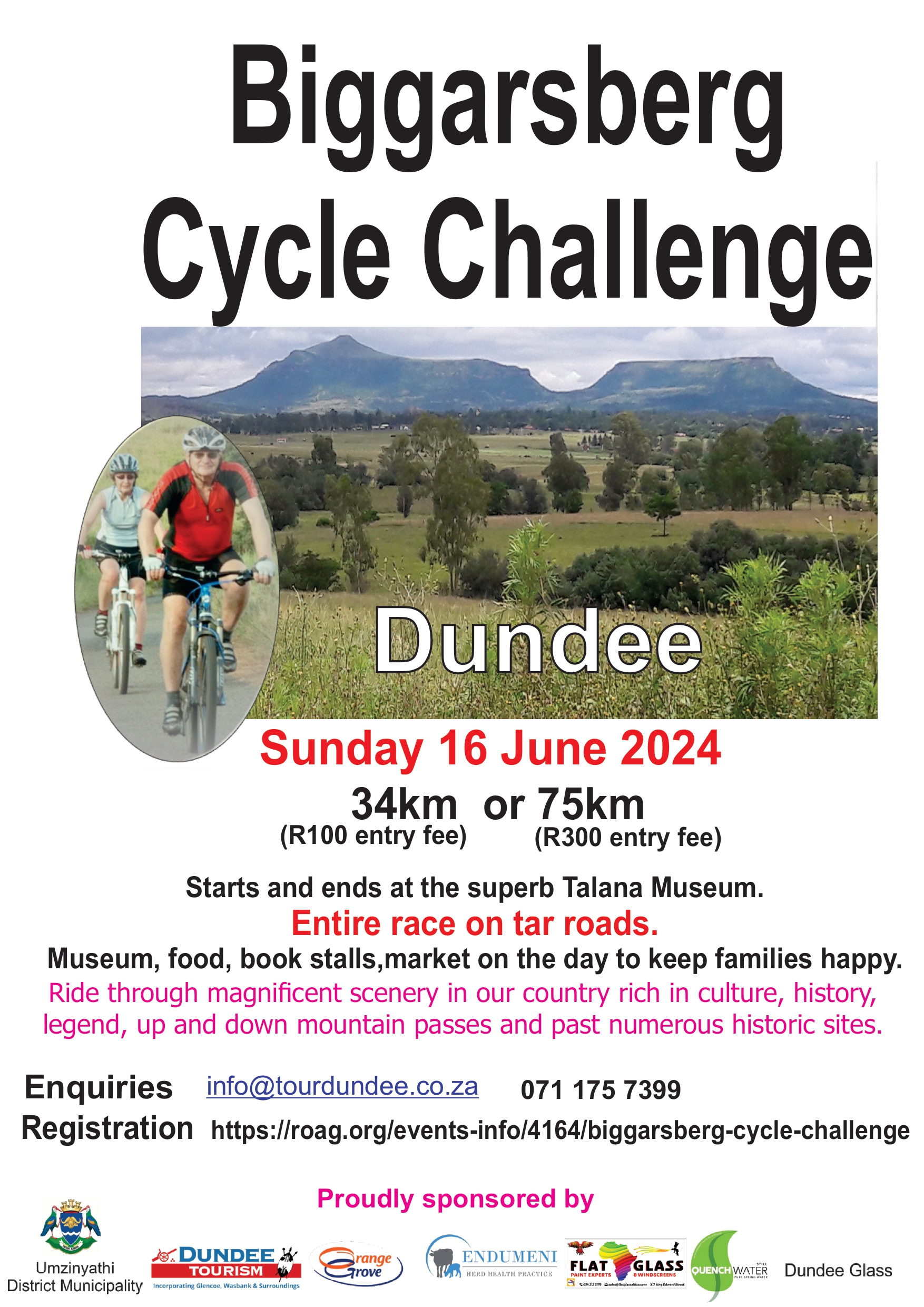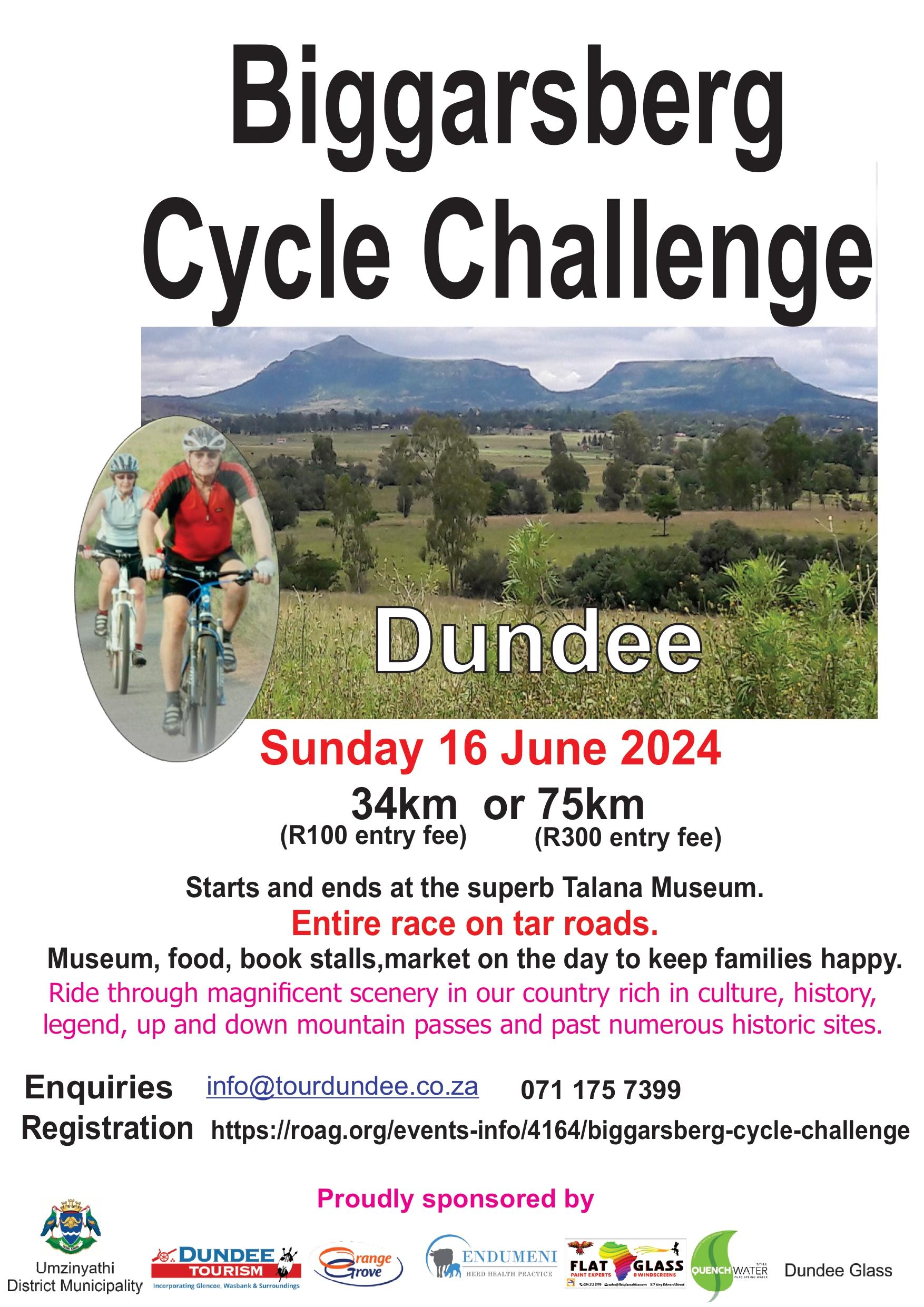Entries & Info
INFORMATION ABOUT EVENT
Biggarsberg Cycle Challenge
The Biggarsberg Cycle Challenge includes:
2 distances,
3 mountains and/or passes and more than 3 historic sites.
Ride through magnificent scenery in our country rich in history, legend and many cultures.
| RACE | START TIME | Price | |
| 75km | 07:30 | Pre Entry effective from 16 Apr 2024 to 12 Jun 2024 ages from 0 to 150 | ZAR 300.00 |
| Late Entry (at Registration) | ZAR 350.00 | ||
| 34km | 07:30 | Pre Entry effective from 16 Apr 2024 to 12 Jun 2024 | ZAR 100.00 |
| Late Entry (at Registration) | ZAR 150.00 | ||
-
75km
RACE DETAILS 75km
- Start point is at the Museum.
- Ride out the museum gate. MARSHALLS
- Pass the Peacevale intersection. MARSHALLS
- Pass the Craigside intersection. MARSHALLS
- At bottom of Victoria St, turn right into Browning Street , sign that indicates cyclists turn right. MARSHALLS
- Turn left in Melville St MARSHALLS
- Turn right into Smith Street – continue along road through Craigieburn MARSHALLS
- After the Endumeni pound , take a sharp right. MARSHALLS
- Continue until intersection with road coming down Mpati mountain and turn left. Have a sign stating busy intersection. MARSHALLS
- At traffic lights at the Traffic testing station turn right. Sharp bend after the testing station. MARSHALLS
- Ride straight ahead. Turn left onto Glencoe bypass. MARSHALLS
- Continue down mountain pass and turn left to By Products. MARSHALLS Follow road to reach intersection on outskirts of Wasbank. MARSHALLS
- At Wasbank intersection turn left. MARSHALLS Continue over Wasbank river and through the valley with climb up Wenkommando pass up Endumeni mountain. MARSHALLS
- Coming into Dundee pass the airfield and take turn to right into Tandy Street. MARSHALLS
- Turn left into McKenzie and follow this all the way to the bottom of the street. MARSHALLS
- At T junction turn left and then right onto Victoria street and return up the hill to Talana Museum. MARSHALLS
There will be additional marshalls at all intersections along the way and at points where confusion could exist. Marshalls will also be at points as re-assurance that you are on the correct road.
-
34km
RACE DETAILS 34km
- Start point is at the Museum.
- Ride out the museum gate. MARSHALLS
- Pass the Peacevale intersection. MARSHALLS
- Pass the Craigside intersection. MARSHALLS
- At bottom of Victoria St, turn right into Browning Street , sign that indicates cyclists turn right. MARSHALLS
- Turn left in Melville St MARSHALLS
- Turn right into Smith Street – continue along road through Craigieburn MARSHALLS
- After the Endumeni pound , take a sharp right. MARSHALLS
- Continue until intersection with road coming down Mpati mountain and turn left. Have a sign stating busy intersection. MARSHALLS
- At traffic lights at the Traffic testing station turn right. Sharp bend after the testing station. MARSHALLS
- Ride straight ahead and continue into Glencoe. MARSHALLS
- At 4 way intersection (Karel Landman and Biggar St) turn right. MARSHALLS
- Follow road over railway bridge and up pass the ABH home. MARSHALLS
- Sharp turn left and up the hill out of Glencoe pass the prison. MARSHALLS
- At Sunset Rd intersection turn right. Ride under the railway bridge and keep right as you come to the intersection with traffic coming in from Dannhauser and Newcastle. MARSHALLS
- Follow the road into Dundee down Mpati mountain.
- Turn left into Craigieburn and follow the road through to and up Smith St. MARSHALLS
- Turn left into Melvill St and then right into Browning St. MARSHALLS
- At the intersection with Victoria street turn left and return up the hill to Talana Museum. MARSHALLS
There will be additional marshalls at all intersections along the way and at points where confusion could exist. Marshalls will also be at points as re-assurance that you are on the correct road.
Other Information About Event
-
Accommodation
Full list available on www.tourdundee.co.za/accommodation
-
Sponsors
Dundee Tourism would like to thank all the sponsors of the event and the many persons who have advised and assisted with advice and personal support.
Umzinyathi District Municipality
Endumeni Herd Health
Flat Glass
Dundee Glass
Orange Grove Dairy;
Dundee Spar
Sweet Talk
Quench Water
OTHER USEFUL INFORMATION ABOUT EVENT
Welcome to the Dundee, Glencoe region.
We have included a few interesting facts about and names of the towns and the places that you will be cycling past.
Enjoy your stay, the cycle raace and do come back for a longer, special visit.
Interesting facts
Talana – the shelf where precious items were
kept in a Zulu chief’s hut
today a superb museum on the site of the
first battle of the Anglo Boer War
Battle fought on Friday 20 October 1899.
It was originally recorded as the battle of
Glencoe, the battle of Dundee and on the
third day as the battle of Talana.
Site of first organized coal mining in South
Africa. Dundee Coal Company floated on
London Sock exchange in 1899, mined into
Talana hill and other sites in and around
Dundee and Glencoe valley
Dundee
Named after Dundee, Scotland. Peter Smith, one of the founders had arrived from Mole Hill farm in Forfarshire, near Dundee, Scotland.
Thomas Smith, his brother had left home in the 1850’s and spent 5 years on the Australian goldfields before coming to Natal in 1855.
He was granted 3000 acres in Northern Natal and named his farm “Dundee”.
Peter Smith married Ann Craighead—they had three children: William Craighead, Isabella Petrie and Elizabeth.
In 1859 they emigrated to Natal. Peter and a fellow traveller, William Duff, leased a farm in the Ladysmith area.
This proved unsuccessful and they were forced to earn extra money by felling trees in the Cundy Cleugh on the Drakensberg Escarpment.
They were paid in cattle and were soon able to return to farming.
In 1864 Thomas built a small cottage on “Dundee” farm and persuaded Peter and Ann and their family to join him.
Thomas was a confirmed bachelor and never married. He continued with his building contracting, whilst Peter took over the farming operations.
They are all buried in the family cemetery at Talana Museum.
Mpati—the place of good waters
Still one of the main sources of water supply
for the towns
Boer forces in October 1899 pulled a Long
Tom gun to the top of this mountain and
fired into British forces and camp during the
battle of Talana. The Long Tom gun had a
range of 10 000 yards (10 miles/16km) and
was one of the deciding factors why the
British forces withdrew from the town .
Site of the Ermelo church— first Dutch
Reformed church in the area.
Glencoe
Named after Glen Coe in the Highlands of Scotland.
The town was originally named Glencoe Junction, as it was a large railway junction.
In time it simply became Glencoe.
Payne’s Farm, not far from the railway station, served as a Boer military hospital during the first stages of the Anglo Boer War from October 1899—February 1900.
Many of the Boer leaders, including President Paul Kruger slept overnight in the village during the Anglo Boer War.
Glenluce Pass
Some references locate Glenluce Pass in the same place as the neighbouring Endumeni (Wenkommando) Pass, which is a few kilometres away to the east.
Anglo-Boer War transcripts refer to this traverse as Uithoek Pass, and would have been correct at thetime, as “Uithoek” farm which was owned by Voortrekker leader Karel Landman, is located at the base of the pass, which is situated just to the south of Glencoe.
Wasbank Laager—Site of the Vow
It is at this laager on the 7th Dec 1838 that Andries Pretorius, Karel Landman and Sarel Cilliers formulated the “The Vow” and it was made for the first time.
The marker is on the side of the Wasbank Dundee road but there is no interpretive material.
The actual site of the laager is across the road from the marker and lay between the hills the river.
Ndumeni Mountain—where the thunder rolls
The highest peak in the Biggarsberg mountain range towers over the valley in which Dundee and Glencoe are situated.
The Biggarsberg is an off shoot of the Drakensberg mountains and ends at Helpmekaar.
The Biggarsberg is named after Alexander Harvey Biggar an ex soldier who settled at Port Natal.
He joined the commando moving into the interior of Natal to confront the Zulu’s, after the killing of Piet Retief and the attack on the Boer laagers in the Estcourt an Weenen
areas in early 1838.
At the base of Indumeni mountain you cross the Biggarsgat river and the farm with the same name.
This is in memory of the Alexander Biggar, who with his Scotch cart and horses, fell into a hole in the river and disappeared under the water.
When he surfaced, he found the Boers, on their horses had formed a circle and laughed at him with the comment “Kyk Biggar het in die gat geval”
“Look Biggar has fallen in the hole.”
After his death in the battle of Opathe kloof the mountains where this incident had happened were named in his memory.
Wasbank
The river was named by the Voortrekkers, as it was on the banks of the river, that they washed their clothes and laid them out to dry on the large stone slabs, that can be seen on the south side of the bridge.
The name of the village came from the river.
Wenkommando Pass
On the morning of 10 December 1838 the Wasbank laager was broken up and the procession of wagons and mounted men, continued up Indumeni mountain.
The original route is slightly to the west of the current tar road.
On the top of the pass, in the farmers field to the west, is a memorial commemorating the route of the Wenkommando.
The name derives from the successful battle of Blood River/Ncome on 16 December 1838.
At the time the mountain was known as The Mud Mountain or the Honey Mountain.
This was due to the very heavy rain fall which made the climb up he mountainside very difficult with the large rocks and the deep mud.
The Honey Mountain was a reference to the local Zulu’s who followed the honey birds to rob the hives of honey, that abounded on the mountain side.







